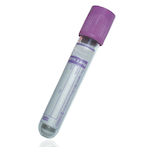
- Home
- Clinical Chemistry Tests
- HbA1c (Glycated haemoglobin)
HbA1c (Glycated haemoglobin)
Specimen Volume
4mLSpecimen Transport
Standard transport to laboratorySample Preparation
Turnaround Time
24 hoursGeneral Information
For more information please see https://labtestsonline.org.uk/tests/hba1c-test
Notes
Samples that meet the following criteria will not be processed:
- Samples from patients who have been transfused within the last 4 months. Only in exceptional circumstances should such samples be processed and only after discussion with Senior laboratory staff or Haematology medical staff.
- Samples taken from IV “lines” should not be used. Contamination with saline will affect the chromatographic separation of the haemoglobin molecules due to changes to the buffer system/gradients.
- A sample volume of <1ml.
- Samples which fail the minimum data set.
- Clotted samples.
Glycohaemoglobin (GHb) is a general term for whole blood glucose complexes that are non-enzymatically bound to alpha and beta chains of human haemoglobin. The most quantitatively prevalent complex is called HbA1C, in which glucose binds to the N-terminus of the alpha chain. The amount of HbA1c formed is directly related to the average level of blood glucose. HbA1c levels do not change quickly due to life span of red blood cells (2-3 months), therefore the HbA1c levels reflects the average blood glucose level during the last 2-4 months. HbA1c measurement is used in the monitoring of diabetes.
In 2011 the WHO advocated the use of HbA1c testing in diagnosing diabetes.
Haemoglobin A1c (HbA1c) testing to diagnose diabetes
An HbA1c of 48mmol/mol (6.5%) is recommended as the cut off point for diagnosing diabetes. A value of less than 48mmol/mol (6.5%) does not exclude diabetes diagnosed using glucose tests.
In patients without symptoms of diabetes the laboratory venous HbA1c should be repeated. If the second sample is <48mmol/mol (6.5%) the person should be treated as at high risk of diabetes and the test should be repeated in 6 months or sooner if symptoms develop.
Situations where HbA1c is not appropriate for diagnosis of diabetes:
ALL children and young people
patients of any age suspected of having Type 1 diabetes
patients with symptoms of diabetes for less than 2 months
patients at high risk who are acutely ill (e.g. those requiring hospital admission)
patients taking medication that may cause rapid glucose rise e.g. steroids, antipsychotics
patients with acute pancreatic damage, including pancreatic surgery
in pregnancy
presence of genetic, haematologic and illness-related factors that influence HbA1c and its measurement (see annex 1 of the WHO report for a list of factors which influence HbA1c and its measurement)
Patients whose HbA1c is under 48 mmol/mol (6.5%)
These patients may still fulfill WHO glucose criteria for the diagnosis of diabetes
The use of such glucose tests is not recommended routinely, but use WHO glucose testing in patients who have symptoms of diabetes or clinically are at very high risk of diabetes
Reference Range
20-42 mmol/mol
Source of Reference Range
WHOSpecifications
- EQA Status: NEQAS
- EQAS Scheme: Yes
Creation Date
Sunday, 02 December 2018Modification Date
Wednesday, 26 November 2025General Information
Location of Laboratories
Copyright UHB Pathology 2025
Protection of Personal Information – Pathology Laboratories Services comply with the Trust Data Protection Policy and have procedures in place to allow the Directorate and it’s employees to comply with the Data Protection Act 1998 and associated best practice and guidance.
The laboratories at Queen Elizabeth Hospital, Heartlands Hospital, Good Hope Hospital and Solihull Hospital form part of the services provided by University Hospitals Birmingham and are UKAS (United Kingdom Accreditation Service) accredited to the ISO 15189:2022 standard. For a list of accredited tests and other information please visit the UKAS website using the following link: https://www.ukas.com/find-an-organisation/
- Molecular Pathology is a UKAS accredited medical laboratory No. 8759
- Biochemistry is a UKAS accredited medical laboratory No. 8910
- Haematology and Transfusion is a UKAS accredited medical laboratory No. 8784
- Clinical Microbiology is a UKAS accredited medical laboratory No. 8760
- Cellular Pathology is a UKAS accredited medical laboratory No. 10141
- United Kingdom Health Security Agency laboratory is a UKAS accredited medical laboratory No.8213
Tests not appearing on the UKAS Schedule of Accreditation currently remain outside of our scope of accreditation. However, these tests have been validated to the same high standard as accredited tests and are performed by the same trained and competent staff.
For further test information, please visit the test database: https://qehbpathology.uk/test-database
For further information contact Louise Fallon, Quality Manager, 0121 371 5962/ 0121 424 1235
 Biochemistry
Biochemistry Haematology and Transfusion
Haematology and Transfusion Clinical Microbiology (Including Virology)
Clinical Microbiology (Including Virology) Cellular Pathology
Cellular Pathology General Information
General Information Molecular Pathology
Molecular Pathology